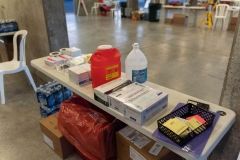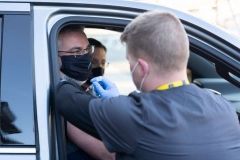
Indiana State Department of Health news release regarding the findings about COVID-19’s impact on Indiana.
IU, ISDH release preliminary findings about COVID-19 impact on Indiana
Indianapolis, Indiana (May 13, 2020) – Preliminary results from a scientific study aimed at measuring the spread of the novel coronavirus in Indiana show a general population prevalence of about 2.8 percent of the state’s population.
“What we knew through conventional detection methods — testing symptomatic people and those at high-risk for COVID-19 — was just the tip of the iceberg,” said Nir Menachemi, lead scientist on the study and a professor and Fairbanks Endowed Chair in the Indiana University Richard M. Fairbanks School of Public Health at IUPUI. “Now we’re trying to figure out how big that iceberg actually is.”
Paul Halverson, founding dean of the Fairbanks School of Public Health, said continued testing will answer this question and assist with fighting the spread of COVID-19.
“Ideally, we would test every Hoosier,” Halverson said. “But the next best thing is random sample testing, a scientific approach that allows us to confidently assess how COVID-19 has spread in Indiana, without having to test everyone.”
As part of the first phase of the study — a 10 Public Health Preparedness Districts. District 9 on the southeast side of the state, which experienced an early facility-based outbreak, was observed to have the highest prevalence of the virus in the general population. The prevalence in districts 1, 5 and 10 was also slightly higher than in other districts.
The way forward
“We’re so grateful for this work. It’s an important snapshot in time of what is happening in our state, and future testing phases will bolster our knowledge,” said State Health Commissioner Kris Box, M.D., FACOG. “These initial results will help guide us in our efforts to make decisions about how we move forward in Indiana and better position resources.”
Menachemi said preliminary results seem to suggest that the state’s physical distancing policies—also known as social distancing—have played a role in curbing the spread of the virus.
Study participants who reported living with a person in their household who was positive for the virus were more than nine times more likely to test positive themselves. Coupled with the study’s relatively low 2.8 percent general population prevalence, this seems to imply that Indiana has been able to contain a large number of infections to within households, he said.
“By slowing the spread of the virus, we now have bought some time to determine the best way forward,” Menachemi said. “However, it is important to stress that the vast majority of the people in Indiana have not been infected and represent the minimum pool of still susceptible individuals. Therefore, as we slowly phase back and open the economy, we need to be extra vigilant with any and all safety precautions so that we do not lose the ground that we gained by hunkering down.”
The next phases of testing are planned for early June, October and April 2021.
Select members of the public will again be asked to participate, by invitation only, to ensure that the sampling is representative of the population.
COVID-19 World Wide Web Resources
Allen County Department of Health COVID-19 Guidance and Local Resources
State of Indiana Web Resources:
- Indiana’s Mortgage Assistance Program
- List of who is eligible to receive the COVID-19 vaccine
- Eligible? Click here to register and make an appointment
- Indiana State Department of Health’s COVID-19 information and stats
Other Web Resources:
- Centers for Disease Control and Prevention’s COVID-19 webpage
- Centers for Disease Control and Prevention’s COVID-19 cases in the United States
- John Hopkins’ COVID-19 Dashboard
- Latest news from Google News















